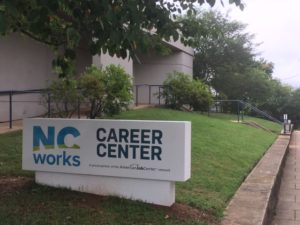The Ongoing Workforce Shortage
Workforce shortages have been on the rise across the United States over the past year, as the COVID-19 pandemic shifted labor markets. Local solutions are emerging as communities collaborate on efforts to connect more people with jobs.

The Problem
Over the past few years, many sectors have become increasingly affected by growing workforce shortages across the nation. Although these shortages increased during the COVID-19 pandemic, they were already on the rise and have the potential to worsen further.
The medical field has been greatly impacted by these shortages. North Carolina was already projected to face a shortage of around 12,500 nurses by 2033 before the pandemic and is now set to face projected shortages of up to 21,000 nurses in the coming decade due to burnout. A shortage of nurses could lead to decreased capacity of hospital beds for patients and the capacity of hospitals to serve patients overall. The efficiency and effectiveness of our entire healthcare system could be at risk, at a time when hospital workers are already under increased stress. Many communities are also experiencing shortages of nursing staff and aides willing to work in nursing homes and long-term care facilities. All of these trends are exacerbated in rural areas, which tend to have aging populations.
Another heavily affected sector is education, with a November 2021 survey indicating that half of all teachers were considering switching positions. In addition to low levels of pay and benefits, teachers say they feel stretched thin, with new expectations and little support. For many since the pandemic began, teaching has been exhausting, and some say it’s not sustainable.
Leisure and hospitality (which includes restaurants and hotels) are still missing 7.2 percent of jobs after the pandemic began, a higher share of jobs still lost than any industry except for mining. This reflects 1.2 million jobs that haven’t been filled compared to job numbers before the pandemic, which has led restaurants to close or work with a smaller staff. The manufacturing and information technology industries are also dealing with similar shortages.
One of the reasons for these shortages could be the lack of rising wages, with people – especially in lower-skilled jobs – not seeing their wages keep up with the currently high rates of inflation, even with recent wage increases. Another potential reason could be that employers are struggling to find creative ways to attract the necessary amount of talent, especially from millennials and Generation Z who make up slightly over one-third of the current workforce. With this younger generation looking for a more worker- and family-friendly job environment, it may be critical for employers to take their needs and mindsets into account when it comes to designing positions.
In July of 2021, the North Carolina Department of Commerce launched its First in Talent plan, which aims to make the state one of the most economically competitive and talent-laden in the country through its three main goals to
- prepare North Carolina’s workforce for career and entrepreneurial success,
- prepare North Carolina’s businesses for success by growing and attracting a talented workforce, and
- prepare communities across North Carolina to be more competitive in growing and attracting a talented workforce and businesses.
The Solution
Some companies have seen higher wages and increased benefits as an effective way to attract people back into the labor force following the onset of the pandemic. Increasingly, women are choosing to work for companies offering more family-friendly benefits.
Other innovations being implemented look for partnerships between businesses and educators. For example, UNC Health is synchronizing with the UNC School of Nursing to incorporate more student nurses into its daily healthcare operations, which serves to both fill workplace shortages in the health industry and give students meaningful, on-the-job experience. UNC Health has also introduced signing bonuses and flexible work schedules to attract new hires, which aligns with nationwide trends of businesses creating an environment that is increasingly responsive to workers’ needs.
Other colleges in the state have stepped up as well to fill high-need positions. Half of graduating UNC-Pembroke nurses are choosing to work in rural areas. Also, North Carolina’s community colleges and universities have increased collaboration, creating a smooth, efficient route for people seeking to transition from becoming a licensed practical nurse to a registered nurse to an advanced practice nurse.
Recognizing that computer-based skills are necessary for most jobs, there are many Information Technology training programs and certifications that can be a faster path to living-wage jobs than a traditional college degree.
The N.C. Chamber, part of the National Association of Manufacturers, is providing recommendations to employers regarding second chances for justice-involved individuals while examining how to reform criminal codes that exclude these individuals from certain positions. The N.C. Chamber also initiated a newly-formed Institute for Workforce Competitiveness that will spotlight solutions, convene and connect experts, and train practitioners in talent pipeline management.
The Players
Large- and small-scale partnerships across the state are working to improve employee retention and help people find the job of their dreams. Maggie Kane is the founder and executive director of A Place at the Table, a pay-what-you-can restaurant located in downtown Raleigh that is focused on giving employees a voice in the workplace. Although the restaurant experienced some employment struggles during the pandemic, it did not experience widespread issues due to its living wages and family-friendly benefits. In addition to providing paid parental leave, which is only offered by 6 percent of restaurants nationwide, the restaurant also relies on partnerships with local companies and job-focused nonprofits to fill employment gaps. Another example of a focus on benefits is the partnership between the Cabarrus County government and a local church, where the church has opened a childcare center specifically dedicated to the children of county employees.
NC Works is an organization that operates approximately 80 career service centers across the state that are dedicated to helping adult workers find meaningful employment. The organization works to understand the background, experiences, and passions of job seekers and helps them identify the credentials they need for the job they want. Each center partners with local community colleges to enroll job seekers in a desired program, while also providing employee training grants to local businesses so they can offer temporary work for people looking to acquire the proper training. The centers also help current workers improve their skills for career advancement.
As the workforce development board serving Mecklenburg County, Charlotte Works leads the way in connecting job seekers and employers, providing skills training and work opportunities for youth and adults, analyzing and sharing data to educate the public on workforce needs, and aligning community partners around workforce initiatives to help make Charlotte-Mecklenburg a place of economic opportunity for all.
The Promise
Many governmental and private organizations are working toward this positive future. As one of the top states for emerging businesses, North Carolina needs a large talent pool to fill the growing number of positions in high-demand industries. MyFutureNC is working to prepare at least 2 million people with post-secondary degrees or highly qualified credentials by 2030, an increase of 700,000 from the number of qualified individuals in 2019. The Kenan Institute of Private Enterprise is working to create a report that identifies where skill gaps continue to exist and is partnering with companies and governments across the state to pinpoint industries in demand.
These types of state-wide efforts present opportunities at the local level to alleviate current and future workforce shortages. To accomplish that – industries, governments, and educational institutions must first ensure that talent and job pipelines continue to exist and that enough people are graduating or earning the necessary certificates to meet workforce needs. This requires investment and coordination with university and community college systems, among other measures. Second, businesses must make sure they are offering the pay and benefits that attract younger generations of workers. It is also important for businesses to cast a wider net to attract and retain talent, such as underserved populations, veterans, and justice-involved individuals.





